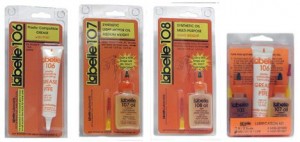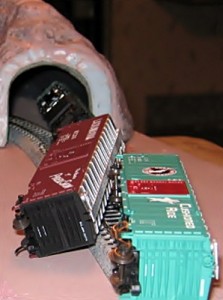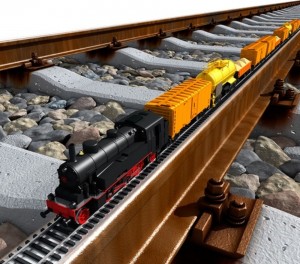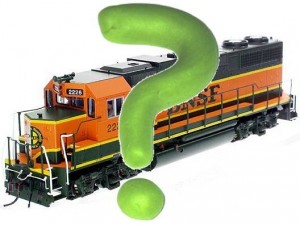Troubleshooting
Everything on model trains, model railroads, model railways, locomotives, model train layouts, scenery, wiring, DCC and more. Enjoy the world's best hobby... model railroading!
Keith wants help from others and asks:
“I have 6 Hooker O Chemicals tank cars #20-96187 from 2009 in which the black snap on foot board and railing assembly has become broken. I had a unit train of Hooker tank cars and it was parked at the edge of the board. My cat (Cinders) jumped up on the train layout and knocked 6 cars to the floor and the catwalk railing broke off. I have tried MTH but they said they had no repair parts. Can anyone suggest a source for parts.”
Add your suggestion below.
Denis asks readers for assistance:
“How do you wire a 3-way turnout (Peco 3 way points) for DCC. There seems to be several ways. Is there a place for using a juicer?”
Scott is hoping for some advice from readers:
“I purchased the Lionel Polar express O gauge for my son for Christmas. Unfortunately it appears that the train engine is broken. The transformer is working, as the other cars are lite up, but the engine doesn’t move, whistle, or light up. Any ideas on how to troubleshoot this train set?”
Add your suggestions below.
Graham has an OO layout and asks:
“What’s the best glue for fixing scatter powder to layout boards?”
James has an N scale layout and asks:
“What are the differences between code 55 and code 80 track and can you combined then on a layout Thanks”
Add your answers below if you want to help.
Sundaram would like some advice from experienced model railroaders and asks:
I am facing the following HO problems:
I have a DCC fitted layout. Zephyr DSCS50 and Digital DS64 Digital Command Control –
1. The mobile decoder (Digitrax – 123HD) failed all of a sudden – seems to have burnt out, because a hole is been on the plastic sheath covering the electronics.
2. The turnout machine keeps switching even when not activated. This specially happens when a non- DCC engine is operated.
Add your suggestions below.
Jack asks readers for help:
“I plan to convert my HO from DC to DCC, so how do I know what decoder to purchase for my engines? How do I match an engine model to a decoder and sound system?”
Doug asks readers:
“Can I run DCC equipped trains on a regular lay out?”
Joel asks:
“Can anyone direct me to a wiring diagram to operate 3 LGB semaphores in a block signal situation? Simple track oval no DCC or similar. Train power from track Semaphores from transformer and track.”
Steve sent in this question hoping someone reading this blog can help him:
“I have a Lionel layout with three separate tracks operated independently from a Z transformer (each track is connected to a separate circuit). I apparently have developed a short which I cannot find but strangely it has affected all three tracks/circuits which doesn’t make sense. Anyone have any suggestions to help me locate and solve my problem other than starting over?”
Add your comments below to help Steve.
We are looking for someone who is highly skilled with DCC to write some informative articles.
If you think this is something you could do; simply use the “Click To Add A Comment” link under this posting to submit your details (and maybe a sample). The blog moderator will be in touch via email. The articles will be used to help others in the hobby learn more about setting up and operating a DCC system. There will be payment for your work.
You might even know someone who might be interested. Please refer them to this blog posting.
 Even though many of us a reasonably experienced in the hobby, getting started can be confusing. Beginners hear all kinds of new terms and have a lot to learn. This steep learning curve can be intimidating and will put many off venturing further into the hobby. This is why it is so important we all help and encourage others.
Even though many of us a reasonably experienced in the hobby, getting started can be confusing. Beginners hear all kinds of new terms and have a lot to learn. This steep learning curve can be intimidating and will put many off venturing further into the hobby. This is why it is so important we all help and encourage others.
DCC or Digital Command Control uses rails to send digital commands to the locomotives in such a way that multiple locomotives are independently controlled within the same block. A DCC system consists of the following components.
Command Station – controls all other parts of the DCC and determines the type of throttle controls that can be incorporated.
Throttle or Cab – acts as hub of the whole system, primarily used for controlling the train.
Booster – amplifies command signals so that enough power is generated for operating the tracks.
Power Supply – supplies power to the entire model as an AC transformer or DC power source.
Decoder – incorporated into each locomotive to provide power to the track, only when it has been addressed.
For lots more information of DCC operation check out the members area inside the Model Train Club. New content is added every month.
Ralph is experiencing derailment problems and asks readers for advice:
“I have a curve in a tunnel. When the train runs right to left on the track all is well. But when I run the train left to right I obtain a derailment. I have manually changed the curvature a little. The area is somewhat accessible. There is no problem either way with small engines just with the longer engines.”
Comment below.
Edward has a question for readers:
“How do I check for a warped rail or track twist or a small level change? My trains uncouple once in a while and leave cars behind.”
Add your comment below.
Damien kindly sent in this tip:
Years ago my father explained to me the advantages of building a grid vs. flat layout when it comes to grades. The grid layout offers both + and – grades. What is advantageous here is that if your trains have bridge or other types of over crossings, then the grade angles can be cut in half. The over crossing could be a +1.5%, where as the under crossing could at – 1.5%. Effectively this equates to a 3% grade on a flat top layout. The distances leading up to and going away from the crossing is now a shorter distance for both the over and under crossing tracks.
This works really well as the gauges go up in size. Just think of O gauges crossings and the clearance you need to clear the trains at the crossing. By cutting the distances to and from the crossings you get more bang for the buck in layout size. And the 1.5% grade sure is easier on the motors too. Of course the grades could be increased to 3% for over and under crossings, and would still be reasonable for the motors, while decreasing to and from distances even more.
Add your comment to this posting.
Regular re ader Ted has been involved in the hobby for 31 years and sent in this tip:
ader Ted has been involved in the hobby for 31 years and sent in this tip:
“In my opinion the gears are the most important parts of your model train mechanics and must be inspected from time to time to identify missing tooth, poor lubrication and damage. I recommend oiling the wheels lightly at least twice in a year but you can oil the wheels whenever the running noise of your train increases. Avoid oil spreading to the traction tires because oil will reduce the grip of traction tires, resulting in the overturning of the coach. And remember oil attracts dust and dirt so you don’t want too much oil anywhere. Use an electronic track cleaner to keep your tracks clean so that tracks can maintain its conductivity. When you lubricate gears use a plastic compatible grease, because oil will simply get thrown off the gears when at high revs, and it will cover everything, whereas the grease will remain in place. However, never over lubricate the gears! Labelle make a lubricant or you could use AJ’s Magic Grease #0197 which is a non-petroleum based lubricant with Teflon. AJ’s Magic Grease works well and sticks okay to plastic surfaces.”
Click on the link to add your comments.
It is a shame William didn’t build his HO layout in modules as he has struck a common problem. Click the link to add your comments to this posting if you can offer some suggestions for William:
“I started with a basic figure 8. But we put our home on the market, and will be moving soon. So I stopped adding to my layout. My problem now is what or is the best way to take it down for the move??”
There are lots of excellent tips in the ebook for building modular layouts at http://www.modeltrainclub.org/club.html
 Regular blog reader John makes a wonderful contribution to the model railroading community by sharing his ideas so others in the hobby can benefit. Here is John’s latest article:
Regular blog reader John makes a wonderful contribution to the model railroading community by sharing his ideas so others in the hobby can benefit. Here is John’s latest article:
A common cause for a derailment is that the track was not put down properly. This could be an upturned rail joiner, particles from the ends of cut track that have lodged in the wheels of the locomotive or cars, dirty track, a “foreign object” that parks itself in the right-of-way, and pinched curved track that does not form a smooth, even circle. This problem becomes even worse when the wreck occurs inside a tunnel.
The first task is to get the cars out of the tunnel. If the tunnel is fixed in place and you model in a small scale, there might be a problem getting your fingers far enough inside the portals to reach the cars, but this can be remedied. Using a soft-bristled toothbrush, attach the non-brush end tightly with tape to a coat hanger to get the length, then SLOWLY and CAREFULLY pull the cars toward you with the soft brush. It might help if a flashlight is put at the other end of the tunnel to see the trapped cars. Once everything is out of there, put the same toothbrush in a bottle of liquid track cleaner and clean both rails inside the tunnel.
The last step is to check the track and to make sure the portal and tunnel is tall enough and wide enough to accept the largest car in the roster, especially around curves. Also inspect the wheels of the cars to ensure that they are riding on the rails properly, as one misaligned wheel can derail a whole train.
Thanks John!
 If you are new to model trains, consider investing in diesel locomotives as some in hobby claim they run better than similarly priced steam engine counter parts. Others in the hobby might disagree. You have the option of cargo and passenger cars, with complete kits available.
If you are new to model trains, consider investing in diesel locomotives as some in hobby claim they run better than similarly priced steam engine counter parts. Others in the hobby might disagree. You have the option of cargo and passenger cars, with complete kits available.
The rails come in various options, but many prefer nickel silver as it ensures better conductivity.
Scenery can be a big investment if you don’t make most of it yourself… it’s fun making scenery!
Always invest in the best engine as you can, and then go on to build the required landscape. The idea here is to create a perfectly running model railroad, otherwise all your efforts on creating a classic model might go in vain.
There are several excellent resources available for beginners (and experienced) hobbyists, including the “Best Selling” Model Train Help Ebook. Model train enthusiasts can also benefit greatly from access the numerous resources inside the online Model Train Club.
 If you have a model railroad question you would like answered, then use the link on this blog to submit your question. If you word your question carefully and provide some useful details, then chances are someone reading this blog will offer a solution. Only the best question will be published. Please spell check your question before submitting it to the blog moderator for approval.
If you have a model railroad question you would like answered, then use the link on this blog to submit your question. If you word your question carefully and provide some useful details, then chances are someone reading this blog will offer a solution. Only the best question will be published. Please spell check your question before submitting it to the blog moderator for approval.
The link to submit your question is on this page.